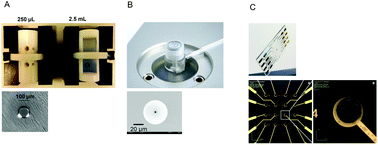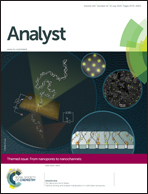Antibiotic translocation through porins studied in planar lipid bilayers using parallel platforms†
Abstract
In general, the method of choice to characterize the conductance properties of channel-forming bacterial porins is electrophysiology. Here, the classical method is to reconstitute single porins into planar lipid bilayers to derive functional information from the observed channel conductance. In addition to an estimated pore size, ion selectivity or transport properties in general are of importance. For the latter, measuring the ion current fluctuation can provide some information about the mode of transport of charged molecules penetrating the proteins. For instance, increasing the external voltage modifies the residence time in the channel: charged molecules with the ability to permeate through channels will travel faster whereas non-permeating molecules get pushed to the constriction zone with enhanced residence time. Here, we are interested in the ability of antibiotics to permeate channels and compare different techniques to reveal fast events.

- This article is part of the themed collection: From nanopores to nanochannels

 Please wait while we load your content...
Please wait while we load your content...